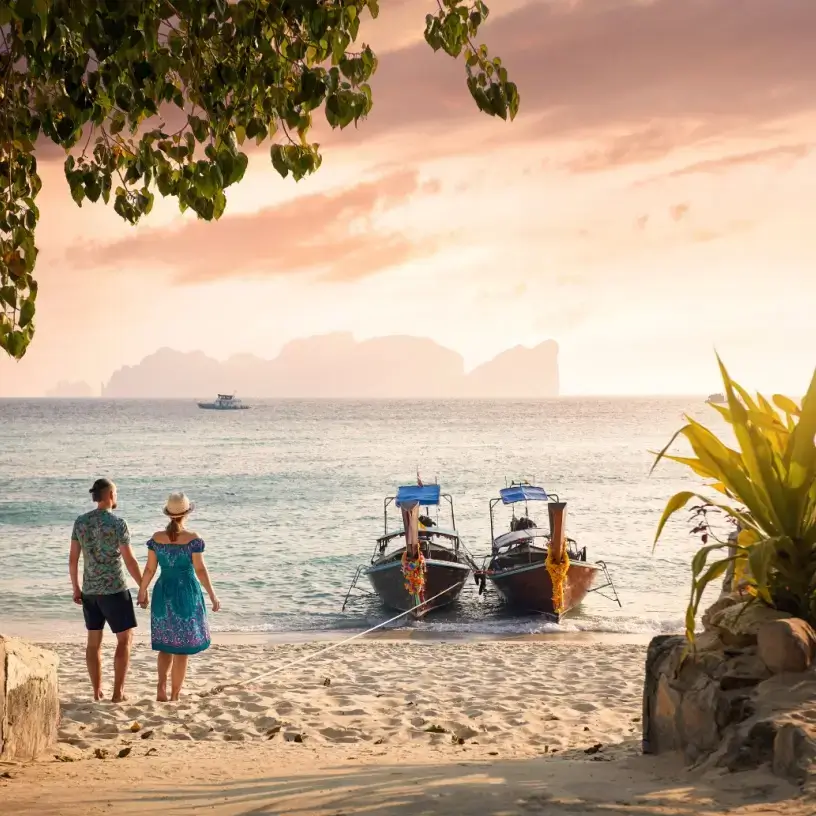Home / Compare Travel Insurance / Travel insurance for the…

Key takeaways
The Philippines is a collection of tropical islands in Southeast Asia, so no matter where you go, there’s a lot to enjoy. But there’s always the possibility of something going wrong, which is where your travel insurance policy can come in handy.
- A travel insurance policy can provide peace of mind by knowing you’re covered for a range of unexpected expenses that affect your trip.
- The inclusions on your policy will vary between insurance providers, levels of cover and if you’ve purchased any additional extras.
- By increasing your excess amount (the amount you pay towards a claim), you can lower your premium. But it’s important to always choose a manageable excess amount.
Why take out travel insurance for the Philippines?
Travel insurance can provide a financial safety net if your adventure doesn’t go to plan. A comprehensive travel insurance policy can cover you for a range of events and may keep you from having to pay unforeseen costs out of pocket. Some benefits include:
- Medical cover. Your policy may cover you if you’re injured or fall ill and need medical treatment while you’re overseas.
- Cancellation cover. Things like natural disasters travel delays, sickness and more can impact your holiday, but cancellation cover may help reimburse you for expenses you didn’t plan for.
- Luggage cover. It can be useful to have your personal belongings covered in case they’re lost, stolen or damaged while you’re overseas, as bag snatching and other scams are common, especially when using public transport or ATMs.
Choosing travel insurance for the Philippines
When you’re looking to buy travel insurance to suit your trip to the Philippines, it’s important to get the right cover. Here are some things to keep in mind when searching for cover:
- Consider what level of cover best suits your trip; while a basic medical-only policy can be budget-friendly, a comprehensive policy will have more inclusions, likely with higher claim limits.
- You can usually choose to purchase optional extras to get coverage for things not automatically covered by your travel insurance policy, such as certain adventure sports.
- By reading your policy’s Product Disclosure Statement (PDS) before purchasing, you can check if you’re happy with your policy’s inclusions, and be sure you understand the limits, sub-limits and exclusions. You can also read the Target Market Determination (TMD) to check if the policy is right for you.
Expert tips for choosing the right travel insurance for your Philippines trip
Before heading overseas, check out the top tips for purchasing travel insurance for the Philippines from our Executive General Manager of General Insurance, Adrian Taylor.

Check if you’re covered for COVID-19
If you’re interested in cover for COVID-19 (coronavirus) related losses, you’ll likely need to purchase top tier cover or a comprehensive policy for COVID-19 cover to be included. Look for the COVID-19 icon when you compare products.
Match your cover to your trip
When you travel, consider what inclusions you want in your policy like medical expenses, cancellation fees, luggage and rental vehicle excess. You may also want additional cover for adventure activities, motorcycle riding or cruises. Keep all this in mind when shopping for a policy.
Declare any pre-existing medical conditions
If you have any pre-existing medical conditions, search for products that allow you to declare these conditions as part of your application to your chosen insurer so they can assess your eligibility. That way, you can ensure you understand what you’re covered for and there are no surprises if you get injured or become ill.
Do I need travel insurance for the Philippines?
It’s always a good idea to consider buying a travel insurance policy for your travels. Depending on the level of cover, travel insurance could help pay for medical costs, including emergency medical assistance, as well as cancelled trips, lost or stolen belongings and more.
In the 2021-22 Consular State of Play, the Philippines recorded the second-highest number of consular assistance cases from the Department of Foreign Affairs and Trade (DFAT), with 555 cases reported.1 While travel insurance can’t cover everything, it can help provide peace of mind and a safety net against financial loss, depending on the level of cover purchased.
When choosing a policy, be sure to read over the PDS for the ins and outs of what your travel insurance covers you for.
Inclusions and exclusions
What travel insurance for the Philippines should cover

Travel insurance policies can differ, so it pays to check what a policy includes or excludes. For a trip to the Philippines, there are a few features you may want to consider including, such as:
Medical expenses cover
Australia doesn’t have a Reciprocal Health Care Agreement with the Philippines, so medical care can be expensive – especially if you need medical evacuation or repatriation back to Australia.
Accidents can happen anywhere, including in well-known cities like Manila or Cebu. Travel insurance may cover your hospital or treatment costs for minor injuries like a twisted ankle to unexpected medical emergencies. The level of cover will depend on the insurance policy purchased.
Natural disasters
The Philippines also experiences various natural disasters, including volcanic eruptions, earthquakes, tsunamis and typhoons. If you’re in the Philippines when a natural disaster occurs, it could cause your flight home to be delayed, damage your belongings and pose a serious risk of injury to yourself.
Depending on the level of cover purchased, travel insurance may cover medical expenses relating to natural disasters, but not all policies will cover all related costs. For example, coverage for volcanic eruptions may need to be purchased as an additional add-on.
Keep in mind, your travel insurance will only cover you if you purchased it before the natural disaster occurred. Read your policy’s PDS for the specifics of your natural disaster coverage.
Personal belongings
Due to the risk of theft and crime in the Philippines, such as pickpocketing, scams and bag-snatching, it may be wise to check that your insurance policy covers stolen, lost or damaged belongings – including cash, credit cards and travel documents. However, if you leave your belongings unattended in a public place, any theft claims may not be accepted.
Trip cancellations and delays
Your travel insurance plan may cover you for disruptions to your trip where you need to re-book or cancel your journey overseas. Trip cancellation and delay cover can also assist you in situations where delayed flights mean you need to purchase emergency accommodation or be reimbursed for activities you can no longer attend.
If you buy comprehensive travel insurance in advance, you can also be covered if an emergency causes you to need to cancel your trip before you’ve even left Australia. The specifics of your policy depend on your insurer and your level of cover and can be found in your cover’s PDS.
Adventure sports add-on
The Philippines is home to some incredible coral reefs. However, snorkelling and scuba diving are not standard inclusions in some travel insurance policies.
If your travel insurance provider doesn’t automatically cover these activities, you may still be able to get cover from them by paying extra for an adventure sports add-on. This is especially important in the Philippines, where many tour operators may not adhere to minimum safety requirements.2
What’s excluded from travel insurance for the Philippines?
Travel insurance exclusions refer to terms and conditions where your provider typically won’t pay a claim for a related event. Common international travel insurance exclusions to watch out for when planning a Philippines holiday include:
- Claims related to alcohol and illicit substances. If you were under the influence of alcohol or drugs, your claim will be rejected. It’s also important to note that the Philippines has strict punishments for anyone consuming illegal drugs.2
- Terrorism, piracy and civil unrest. The Philippines experiences terror attacks, with some regions having a higher risk than others. Furthermore, there’s a danger of maritime piracy and kidnapping in specific parts of the Philippines. While some travel insurance policies provide medical coverage for injuries incurred due to armed conflict, damaged or stolen belongings may not be covered.
- Activities not covered in your policy. Even with a sports cover add-on, some activities and the medical costs for resulting injuries may not be covered.
- Leaving your bags unattended. If you leave your belongings unsupervised in a public space and these are stolen, your insurance provider may not cover the costs.
- Visiting areas with a ‘Do not travel’ warning. Due to instances of violence and political conflict or natural disasters in the Philippines, areas of the country may receive a travel warning from DFAT. It is important to check travel warnings put into place by the Philippine Government and the Smartraveller website before travel. If you travel to a country with an active ‘Do Not Travel’ warning, your policy is unlikely to provide any cover if you suffer a loss.
Meet our travel insurance expert, Adrian Taylor
As a General Insurance expert with over 13 years’ experience in financial services, Adrian Taylor believes in educating customers about the importance of travel insurance so that anyone can kick back and make the most of their time away from home. While no one wants a disrupted holiday, a suitable travel insurance policy can provide a financial safety net for yourself, your belongings and your trip in case things go wrong.
1 Department of Foreign Affairs and Trade, Australian Government. Consular State of Play: 2021-22. Accessed September 2023.
2 Smartraveller, Department of Foreign Affairs and Trade, Australian Government. Philippines. Last updated April 2023. Accessed September 2023.


